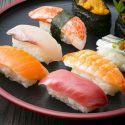寿司に天ぷらなど「東京の食文化」に関する豆知識 Trivia on Sushi, Tempura, and Other Dishes in Tokyo’s Food Culture
和食の代表格・寿司といえば、東京の「江戸前寿司」が有名ですが、実は屋台の寿司屋が元祖であることをご存じですか?今回は日本人でも意外と知らない「東京の食文化」の豆知識をご紹介します!
Sushi is the representative dish of washoku (Japanese cuisine), and Tokyo’s Edomae-style sushi is famous in this genre. But did you know that the pioneers of this dish are actually yatai (stall or cart) sushi shops? Below are some facts about the so-called Tokyo food culture that, surprisingly, even Japanese people do not know!
東京の食文化の歴史 History of Tokyo’s Food Culture
全国から多様な食材や料理が集まる食の中心地、東京。なかでも非常にポピュラーな「4大和食」ともいえる「寿司・蕎麦・うなぎ・天ぷら」は、江戸時代(1603〜1867年)、文化の中心地だった江戸(現在の東京)と深い関わりがあります。
Tokyo is the heart of food culture, and is where various ingredients and dishes from all over Japan gather. There are four major washoku dishes – sushi, soba (buckwheat noodles), unagi (eel), and tempura – and these dishes have a deep relationship to Edo (currently known as Tokyo), which was the center of culture during the Edo period (1603 – 1867).
現在の和食の代表格は江戸のファストフード? Is Edo’s Fast Food Representative of Washoku Today?
江戸時代、主に「寿司・蕎麦・天ぷら」は屋台で提供される、いわばファストフードのような存在として江戸の町民たちに愛されていました。その理由のひとつが、当時の江戸は単身の独身男性の割合が高く、手軽な屋台の料理が特に好まれたということ。江戸は1657年に起こった大火により大部分が焼失してしまった土地。その復興のために地方から働き手がたくさん流入してきたこと、さらに「参勤交代(大名が一定期間交代で江戸に参勤した制度)」によって地方から参勤している武士も多くいたのです。また、せっかちであるとされる江戸町民の気質からしても、さっと食べられる屋台食は性に合ったようですよ。
During the Edo period, sushi, soba, and tempura were mainly served at stalls and carts, and the Edo townspeople loved them as dishes that had a fast food-like presence. One of the reasons behind their popularity was the fact that the ratio of single men during that era was quite high, and they preferred eating at the stalls because of the convenience and simplicity. A large chunk of Edo was destroyed by the massive fire that broke out in 1657. To restore the area, a lot of workers from rural areas flocked to Edo, and there were many samurai from the provinces that moved there under the Sankin Kotai (system wherein the daimyo (feudal lords) were required to reside in Edo for a certain period of time). Stalls that made eating quickly possible perfectly fit the temperament of the people in Edo, who were known to be impatient.

江戸前寿司 Edomae Sushi
元々「江戸前」とは、「江戸の前=東京湾(江戸湾)」で獲れた魚介類を使った寿司のことを指したもの。また、一口大に握った酢飯の上に季節の魚介類の切り身などをのせた「握り寿司」のことも「江戸前寿司」と呼んでいました。そのようなスタイルが誕生したのは江戸時代のこと。また、冷蔵技術も交通手段も発達していなかった当時、ネタとなる魚介類の鮮度を保てるよう、加熱して煮る・酢や塩で締める・醤油などのタレに漬け込むといった仕事も誕生したと言われています。
The term “Edomae” originally referred to sushi that used fish and seafood caught in “Edo no mae = Tokyo Bay (Edo Bay)”. Nigirizushi that had a slice of in-season seafood on top of bite-sized vinegared rice was also called “Edomae sushi” in the past. This style of sushi was born in the Edo period. It was also at that time, when refrigeration technologies and transportation were not yet developed, that methods aimed at keeping the seafood fresh were born – heating and simmering, marinating in vinegar and salt, or soaking in soy sauce and other sauces.
関連記事 Recommended posts
これであなたも寿司通!?寿司の歴史と地域による特色 Become a Sushi Expert! Sushi History And Local Characteristics

蕎麦 Soba
日本の国民食「蕎麦」が現在のようなスタイルになったのも、江戸時代のこと。それまでは蕎麦粉に熱湯をかけ、こねて餅状にしたものを汁につけて食べていました。その後、現代の蕎麦のベースとなる麺状の「蕎麦きり」と呼ばれるものが登場し、さらに蕎麦粉に小麦粉を混ぜた蕎麦を茹でたものなども生まれました。つゆにはほんの少しだけ浸し、二・三口程度噛んで、すぐに飲み込むのが「粋な江戸流」の蕎麦の食べ方とされています。
It was also during the Edo period that soba – Japan’s national food – transformed into its current style. Up until then, buckwheat flour was kneaded with hot water, molded into rice cake-like shapes, and then dipped in soup before being eaten. The noodle-shaped “sobakiri” (buckwheat noodles) that has become the base of present-day soba debuted thereafter, followed by boiled soba that is made by mixing buckwheat flour with wheat flour. The way to eat soba in the way of “iki na Edo-ryu” (refined Edo style) is to soak just a little bit of the noodles in the soup, chew 2 – 3 times, and then quickly swallow.
関連記事 Recommended posts
知っておきたい「そば」にまつわる豆知識

うな丼・うな重 Una-don and Una-ju
「江戸前」とは、元はうなぎに対して使われる言葉だったと言われています。江戸時代の東京湾は天然うなぎの宝庫。隅田川の河口部と深川で獲れたものだけを「江戸前」と呼び、滋養強壮に効果のある食材として江戸の町民たちに愛されていました。
日本人は約4,000年前からうなぎを食べていましたが、現在のような「蒲焼き」スタイルが浸透したのは、江戸時代後期頃のこと。うなぎの切り身に醤油・砂糖などを混ぜた甘辛のタレを塗り、炭火で焼き上げたものです。一度蒸してから焼くのが東京流で、身がふんわり柔らかいのが特徴。白米の上に蒲焼きをのせた「うな丼」または「うな重」はとても人気のある料理です。
The term “Edomae” was apparently used in reference to unagi (eel) at first. Tokyo Bay was considered as a treasure trove of wild unagi during the Edo period. The eels caught at the mouth of Sumida River and Fukagawa were the only ones that were called “Edomae” back then, and the people of Edo loved them as an ingredient that provided them with plenty of nutrition.
Japanese people began eating unagi around 4,000 years ago, but the kabayaki style that is the mainstream today only spread right around the latter part of the Edo period. Kabayaki is when eel slices are covered in salty sweet sauce made from soy sauce, sugar, and other ingredients, and then broiled over charcoal. In Tokyo, the unagi is broiled after a round of simmering to give its meat a distinctive fluffy and soft texture. Una-don and una-ju – made by putting kabayaki on top of white rice – are very popular unagi dishes.
関連記事 Recommended posts
東京で味わう“絶品”うなぎの老舗5選
5 Long-established Restaurants in Tokyo Where You Can Enjoy “Extraordinary” Unagi

天ぷら Tempura
1573~1603年頃、キリスト教の宣教師とともに日本へやってきた「天ぷら」。元は長崎県から広まった魚介類の揚げ物のことで、当時は衣をつけずに揚げたり、すり身にしたものを揚げていたそうです。現在主流の小麦粉などの衣をつけて揚げるスタイルは、16世紀に西洋から伝えられて以降、17世紀に京都で流行したのち、18世紀に江戸で屋台料理として広まったもの。今では魚介だけでなく野菜の具材もポピュラーです。
Tempura came to Japan around 1573 – 1603, together with Christian missionaries. It was originally deep-fried seafood from Nagasaki, and at that time, it was fried without batter, or made into a paste and then fried. The current main style of frying, wherein the ingredient is covered in batter made from wheat flour and other ingredients, came from the West in the 16th century. It was passed on to Kyoto in the 17th century, and then spread as a food stall dish in Edo in the 18th century. Today, it is not only seafood that is made into tempura, as vegetable tempura is also popular.
関連記事 Recommended posts
東京で食べられる天ぷらの名店5軒
5 Best tempura restaurants in Tokyo

今回ご紹介した料理は都内の各専門店などで食べることができますよ。
※本記事の情報は執筆時または公開時のものであり、最新の情報とは異なる可能性がありますのでご注意ください。
出典:WOW!JAPAN


